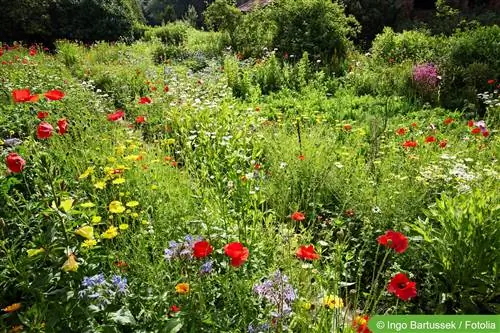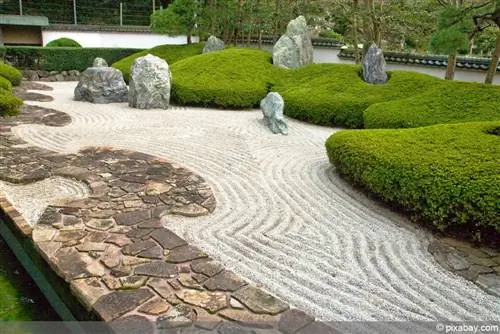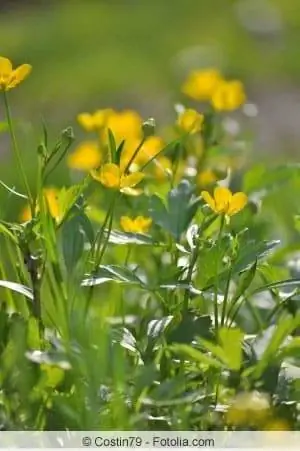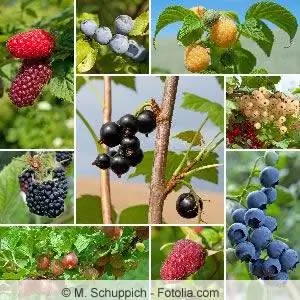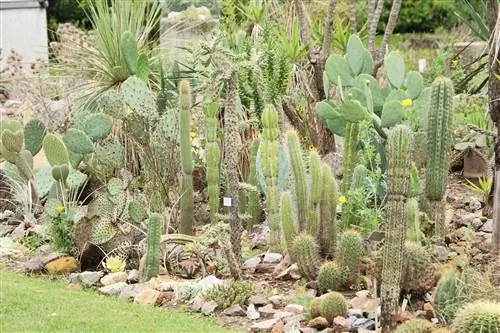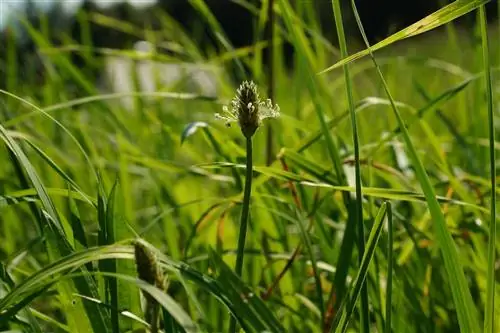- Author admin [email protected].
- Public 2023-12-17 03:39.
- Last modified 2025-06-01 06:48.
Natural gardens offer a piece of native plant and species diversity right on your doorstep. Anyone who would like to call such an oasis of well-being their own and at the same time want to make an important contribution to nature conservation can fulfill this wish using simple means. Natural gardens offer the ideal retreat for people and animals alike. Gardening in harmony with nature doesn't require a lot of effort. Even mature gardens can be transformed into a natural garden with the right planning.
An oasis for local flora and fauna
Natural gardens are rich in species and offer native birds, insects and other animal species an ideal retreat. The variety of native shrubs and trees are a magnet for butterflies, but bees and bumblebees also gratefully accept the food available. However, the ecologically valuable protected space must under no circumstances be left to its own devices. Because even a natural garden requires a basic level of care so as not to degenerate into a landscape covered in weeds.
Ecogardens - as natural gardens are often referred to - offer numerous advantages. For example, all native plant species are winter hardy, so the need for complex preparation to protect them from frost is almost completely unnecessary. The location and size of the property, however, are of secondary importance. With simple means you can, for example, create a natural natural paradise from small front gardens or hillside properties.
Planning and first steps
Before you grab a pickaxe and shovel, you should first start planning your garden. A rough sketch will help you keep track of future beds, hedges, etc. Soft and flowing shapes are ideal for a natural garden. If you don't want to redesign an entire garden at once, you can start with small corners and slowly expand them. The first sensible implementation would be, for example, to create a living privacy fence. After a short time, the bushes serve as a nesting opportunity for birds, and berries enrich their menu. In a natural garden you should only use natural building materials such as wood and stones. Here you can put your imagination and creativity to the test. A few useful tips on how you can design your garden close to nature using simple elements:
- Use a gravel bed for paths instead of concrete slabs.
- Bed borders can be created from found and reading stones.
- Old tree trunks are an interesting eye-catcher.
- Low decorative fences can be made from willow and hazelnut shoots.
- A stream or small pond serves as a biotope for frogs etc.
Decorative elements such as bed borders or large boulders are, however, of secondary importance. Because a natural garden thrives on its plant diversity, which is almost exclusively limited to native plants and trees.
Grasses for the wild garden
- Reed (Phragmites australis): The plants can reach a height of up to 5 meters. Ideal for delimiting bank edges or wet meadows. Extremely easy to grow and reproduce.
- Pipe grass (Molinia caerulea): Bushy growing grass variety. Can reach a height of up to 1 meter and produces blue-violet flowers in mid-summer.
- Forest marbel (Luzula sylvatica): An evergreen plant that thrives optimally even in shady locations. Needs moist and humus-rich soil.
- Blue Schillergrass (Koeleria glauca): The grass feels comfortable in rock gardens and on poor soils. The leaves are blue-green and narrow in shape.
- Snow marbel (Luzula nivea): The ornamental grass is suitable for planting under trees and trees. Snow marbel has evergreen leaves and can only cope with full sun to a limited extent.
Ideal wild shrubs and perennials
Woods fulfill several functions in the wild garden. On the one hand, they delimit certain garden areas, create romantic corners or serve as an opaque hedge. The dense network of branches offers the ideal breeding space for the offspring of birds and small mammals.
- Dog Rose (Rosa carnina): The tree prefers a humus-rich substrate and sunny locations. With its 3 meter height it is ideal for use as a flowering privacy screen. Extremely compatible with cutting.
- Potato rose (Rosa rugosa): Suitable for group or individual planting. The plant produces pink flowers and reaches a maximum height of 2 meters. The flowering shrub is also suitable for cultivation in partially shaded areas.
- Hazelnut (Corylus avellana): The native plant produces nutritious fruits for humans and animals in autumn. Fast-growing shrub with a height of just over 3 meters.
- rotten tree (Rhamnus frangula): The 3.5 meter high shrub does not place any special demands on the location. The dull green foliage creates an interesting eye-catcher in hedges and as a solitary plant.
- Elderberry (Sambucus nigra): Undemanding hedge plant, thrives in sunny and partially shaded places. The fragrant and fruity tree offers black berries, which are also edible for humans in cooked form.
Perennials are also an indispensable part of the natural garden. When planning, you should give these plants enough space. Bee and butterfly pastures provide nectar-seeking insects with a rich source of food. The selection of native perennials is large. Here is a small list of the most popular flowering plants:
- Sage (Salvia nemorosa): A summer bloomer about 40 to 50 cm high that exudes a fragrant scent. The long-lasting plant requires a place in full sun.
- Sedum(Sedum telephium): Late-blooming plant with impressive inflorescences. The robust plant is just as suitable for planting in borders as it is as a pot plant. Depending on the species, the stonecrop reaches a height of up to 55 cm.
- Marjoram (Origanum vulgare): The spice is an indispensable part of your kitchen and should not be missing in any natural garden. The pink flowers appear from July to September, marjoram requires a sunny and nutrient-rich location.
- Goldenrod (Solidago cultorum): The perennial does not get its name by chance, because the panicle-shaped flowers bathe the garden in a sea of gold.
- Little Lady's Mantle (Alchemilla erytrhopoda): Compact growing perennial that reaches a height of up to 20 cm. The perennial plant is ideal for cultivation in rock gardens and on dry stone walls. However, it can also cope easily with a partially shaded location.
- Foxglove (Digitalis purpurea): The plantain plant reaches a height of 2 meters. The plant has impressive flowers, but is considered highly poisonous. A sunny spot is required.
- Forget-me-not: The light blue flowers of this small plant characteristically shine. The compact ornamental flower looks particularly good in a group planting.
Conclusion of the editors
A natural garden attracts many endangered animal species and also offers hobby gardeners the opportunity to sit back and enjoy the peace and quiet of nature. The amount of care required is limited because almost all local shrubs, perennials and trees are hardy. Species-rich wildflowers sow themselves and shine in a variety of colors. Little planning and work is required to transform an ornamental or kitchen garden into an ecologically valuable wilderness.
What you should know about creating a natural garden
The natural garden also has little in common with a piece of nature untouched by human hands. But the organic gardener at least takes nature as a role model. Much of what we generally consider to be natural only came into being through human design. Today's Central European forests have been planted; with a few exceptions, real virgin forests no longer exist. The open, lush green meadows where cows graze peacefully were once covered by primeval forests. And even in the natural garden this is not completely different, it's just that the interventions here are better adapted to nature. Here too, the gardener is the creative force. It is not for nothing that we should speak of being close to nature, because there can be no such thing as a natural garden.
Characteristics of a natural garden
- The natural garden is dominated by plant forms that can also be found in nature.
- This principle is easiest to use in ornamental and leisure gardens: soft lines and gentle transitions determine the look.
- Strictly geometric horizontal or vertical lines, circles and rectangles are missing.
- Precisely cut lawn edges, borders drawn with a compass and figuratively trimmed privet bushes disrupt the picture.
- Fruit and vegetable gardens are clearly alien to nature, no matter how fertilized and sprayed.
- Any area not needed to grow food should be offset by “tamed wilderness.”
- Native trees or taller perennials that protrude from lower plantings create spatial structures.
- A combination of plants that also occur in nature in their neighborhood would be exemplary.
Tip:
The red dogwood, for example, is associated with the trees blackthorn, hawthorn, hazel, clematis and clematis. Wild perennials can be considered as successful underplanting.
- Soft, flowing shapes are in the right place in the ornamental garden, in the natural garden the vegetable beds are conveniently laid out in a rectangular shape.
- But here too, the geometric rigor can be visually relaxed by planting wild plants on the edges.
Natural garden and its boundaries
- The natural garden cannot replace a nature reserve and certainly not a park.
- It is hardly possible to realize closed material cycles in gardens. Planting, harvesting and fertilizing remain unnatural interventions.
- On the other hand, for most people, the garden is the only way to cultivate a piece of land.
- Against this background, the method of gardening close to nature is preferable.
- The aim must be to eliminate fences - which often exclude hedgehogs and other beneficial insects - or to replace them with wild hedges and woody plantings.
Tip:
If several neighbors join together, the positive impact on the environment is greater than the sum of the individual areas.

